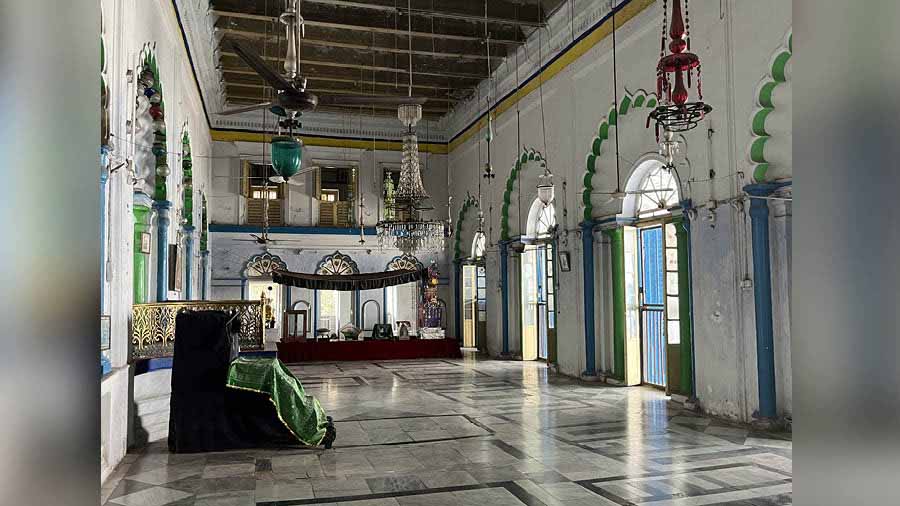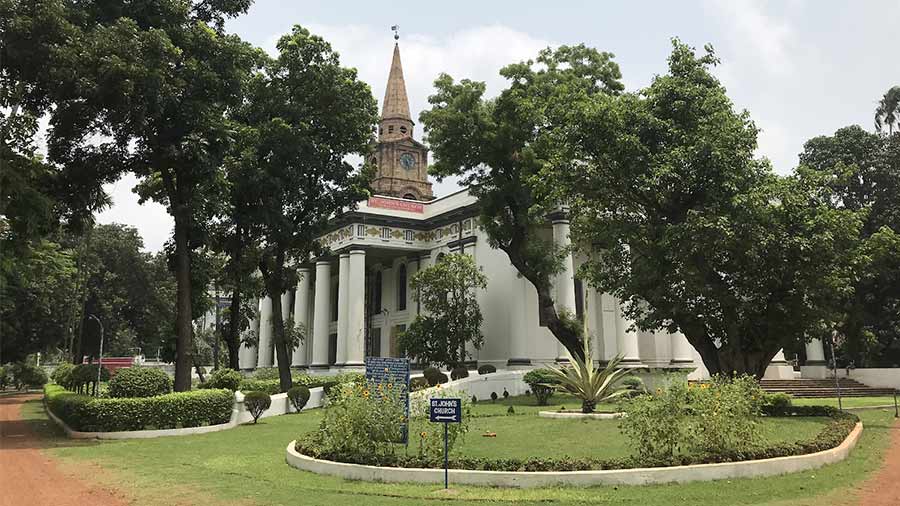The unfortunate Wajid Ali Shah was a king without a kingdom. Caught between “two mutually opposed forces, the dying Mughal Empire and the expanding British one”*, he was stripped of his powers as the Nawab of Awadh, forced out of his capital Lucknow, and exiled to Kolkata, where his new masters — the East India Company — could keep an eye on him.
Wajid Ali Shah landed in Kolkata when he was still just 34. He spent the remaining 26 years of his life here and is buried in Metiabruz, a locality that he defined and created, and which till today, is referred to as Kolkata’s mini-Lucknow.
Taken by stealth: Events in Lucknow and the annexation of Awadh
When Wajid Ali Shah ascended the musnud (throne) of Awadh in 1847, the heyday of his kingdom was firmly in the past.
The Nawabs of Awadh had ruled their domain since 1722. Founded by the able Saadat Ali Khan, who was appointed the Governor of Awadh by the Mughals, they gained prominence over the next century as the Mughal Empire dissolved. Shifting their capital from Faizabad to Lucknow, the Nawabs studded the city with string of glorious monuments showcasing their wealth and grandeur.
It was this wealth that the East India Company desired. Over the years, the English methodically took control of Awadh’s autonomy. Starting with British victory at the Battle of Buxar in 1764, when the Company annexed parts of Awadh territory, to the establishment of Company troops in Awadh (ostensibly to defend the Nawab…), to placing of a British Resident at the Nawab’s court; they gradually dictated all political and military decisions, even taking loans worth nearly £5million pounds* from the Nawabs to finance British interests.
So, what Wajid Ali Shah inherited was a meaningless kingdom with the Nawabs “…like plaster statues on their own palaces, presenting a gorgeously rich exterior, but almost hollow within”*
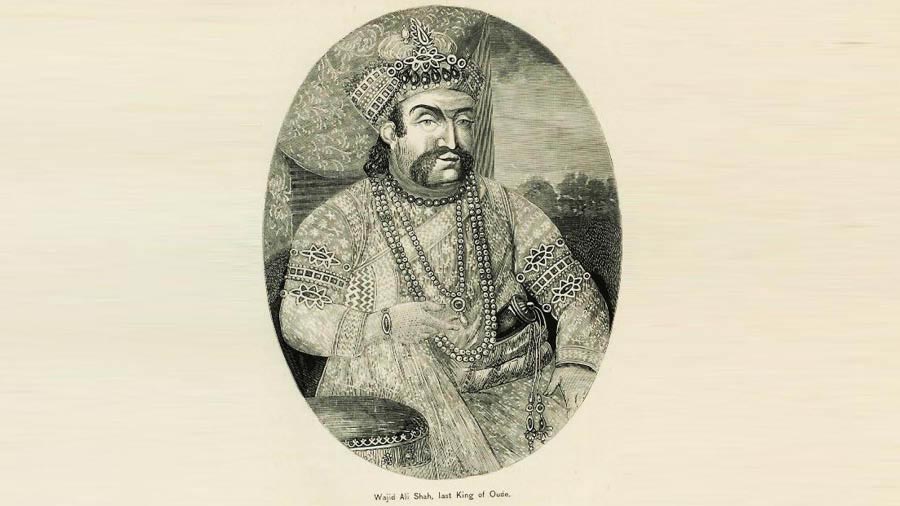
Wajid Ali Shah, the last nawab of Awadh Wikimedia Commons
By the 1850s, the prize was ripe for plucking. It was decided to annex Awadh and Governor General Lord Dalhousie, along with Colonel James Outram, the British Resident at Lucknow, were the key executors. On February 4, 1856, Outram presented Wajid Ali Shah two documents — a letter from Governor General Dalhousie saying that the British Government could no longer support the Awadh regime, and a draft treaty in which the Nawab would sign away his rights to the revenue of the kingdom and agree to Awadh being “vested forever in the Honorable East India Company”*
A shocked Wajid Ali Shah refused to sign, dramatically taking off his turban and placing it in Outram’s hands in frustration. But Outram gave him three days to change his mind, and when no word came from the palace, he formally deposed the Nawab and annexed the Awadh province at noon on February 7, 1856. Awadh had been taken by stealth.
Garden Reach, Metiabruz and the legacy of Wajid Ali Shah
Wajid Ali Shah was left with no choice but to travel to Kolkata to petition the Governor General. If he could not get agreement to having the annexation reversed, he planned to go to London and meet with Queen Victoria. After a two-month boat journey down the Ganges, he landed at Bichali Ghat in Kolkata on May 13, 1856. He would never return.

Bichali Ghat during Mahalaya Wikimedia Commons
At that time, this quiet part of Kolkata called Garden Reach, about 4 miles south of the main city, had a sprinkling of fine houses built by rich Englishmen, with spacious lawns sloping down to the river bank. Wajid Ali and his retinue were given three of these houses, and the home that the Nawab stayed in himself (which he named Sultan Khana) is today the residence of the General Manager of South-East Railways.
Events were soon overtaken by the Great Uprising of 1857, when Indian sepoys revolted against their British masters. Afraid that the Nawab could join hands with the rebels, he was taken from Garden Reach and placed under watch at Fort William, where he remained, isolated and miserable, for the next two years. Eventually, Wajid Ali Shah signed a deal with the English; he would accept an allowance of Rs 1 lakh a month, get a vast tract of land at Metiabruz – a few miles from Garden Reach – where he could do as he pleased, and in return, he would give up his claims on Awadh.
The Nawab now came to live in Metiabruz, and for the next many years till his death, this was the centre of his existence. A second Lucknow now arose on the outskirts of Kolkata, with “…the same bustle and activity, the same language, the same poetry, conversation and with…kite-flying, cock-fighting, quail-fighting, the same opium addicts reciting the same tales, the same observance of Muharram…the same Imam Baras”*
A walk through the sights and sounds of Metiabruz
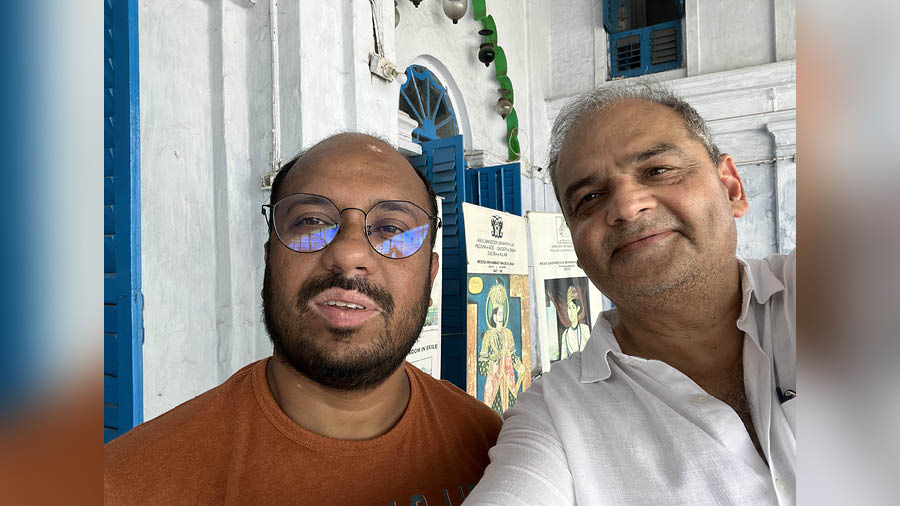
Knowledge transfer in Metiabruz! Adil Ahmad with Shaikh Sohail
I was lucky to walk through Metiabruz with the articulate Shaikh Sohail, who combined the knowledge of an insider with expert storytelling.
Our first stop was the Qasrul Buka Imambara. This is one of the five imambaras and twp mosques that still exist in Metiabruz from the days of the Nawab. It’s not a surprise that only the religious structures survive, for the bulk of the Nawabs’ properties was auctioned after his death to a variety of bidders.
The Qasrul Buka was built by women members of the Nawab’s family. We entered a small courtyard, surrounded by the home of the khidmatgar’s (caretaker) family. As it was nine in the morning, the doors were still locked and the family fished out the keys to open it for us. It was the first time I had entered an imambara. We sat on the carpet, where Sohail and I discussed the context. Muslims have two primary sects – the Sunnis and Shias. The Lucknow nawabs were Shias, which explains the presence of imambaras that are mainly Shia buildings. Imambara literally means the house of the Imam. It is open to both sexes, for people to come for ziarat (pilgrimage). The main assembly hall is used for majlis (a ritual congregation) where those gathered mourn the martyrdom of Hussain and his followers at the Battle of Karbala. The imambara is not a mosque, though at times a mosque may be attached to it – but not to this one.
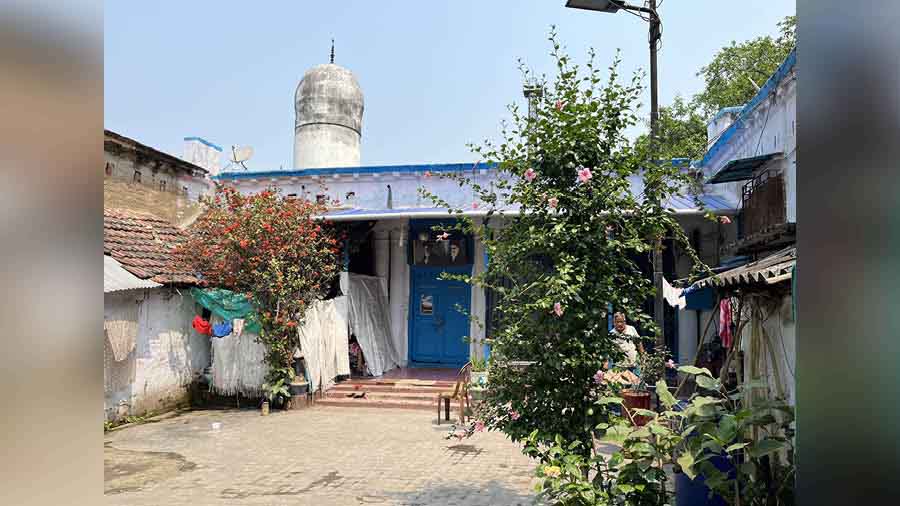
The Qasrul Buka Imambara – dignity, and a quiet place for reflection within modest surroundings
We stood in front of the tazia, which is a miniature imitation – made of bamboo and colored paper – of the Tomb of Imam Hussain. On the 10th day of Muharram, when Imam Hussain is believed to have died at the Battle of Karbala, tazias are taken in a procession through the streets to a lake or river where it is immersed in the water.
This tradition of tazias seem influenced by practices that are mainly Indian. In Iran, which is a center of Shia Islam, tazia literally means a passion play or theatre performed on religious themes. But in the Indian sub-continent, it includes mini-relics of the Tomb of Imam Hussain, taken in a procession for immersing in water.
A paan fit for the nawabs
Stepping back on to the busy main road, we made a pit-stop at a legendary local paan shop which had apparently served paan to the Nawab himself. The original shop was closed due to the death of its proprietor, but in the spirit of local enterprise, the adjoining Panna Lal Chaurasia paan shop was doing great business. A massive photo of the last Nawab adorned the back wall with the message “in memory of Wajid Ali Shah and family in Metiabruz”. I bought my saada paan, and chewed like a Nawab.
Paans are another legacy of Kolkata’s mini-Lucknow. Betel leaf was of huge importance in Lucknow society where it was common for servants to carry a betel box when their masters would go out. This bit of Awadhi culture was transported to Kolkata, as were other aspects like the all-popular biryani, kite-flying and darzis (tailors) to cater to individual clothing tastes. Even today, Metiabruz remains a major producer of kites of different varieties as well as a trading hub for garments.
Having swallowed my paan, we walked towards Iron Gate Road, named after an iron fence that marked the southern boundary of the Nawab’s estate, and the lovely Shahi Masjid, built by Wajid Ali Shah himself.
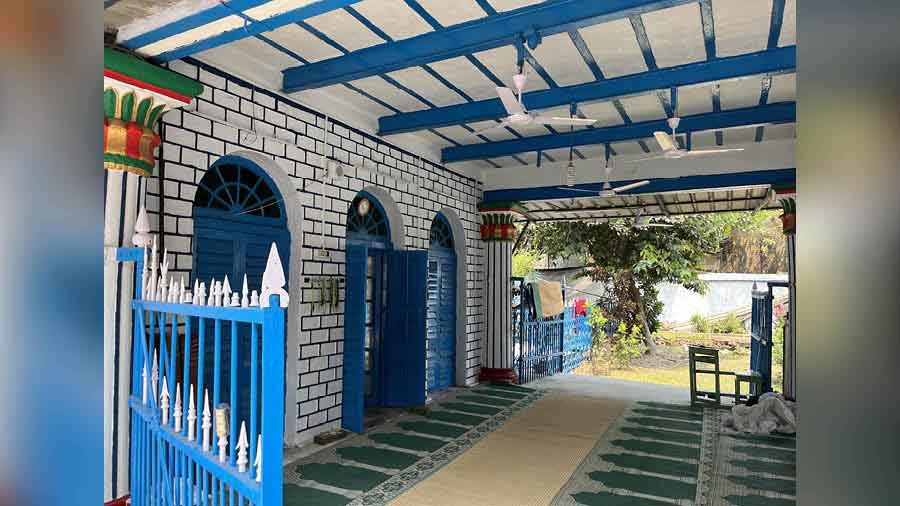
The small and intimate Shahi Masque; the Nawab himself laid the foundation stone
The name may suggest something grand, but Shahi Masjid is in reality small and intimate, reflecting the paucity of funds at the Nawab’s disposal. The simplicity of its structure, its quiet “tucked-away” atmosphere – with birds chirping in a small patch of lawn as the sounds of traffic recedes in the background – is what makes it so charming. The mosque was empty apart from a caretaker who showed us around. We walked past a long wuzu pond, used for ablutions, that had fish in it.
There is a delightful back-story about how the mosque got built. Apparently, Wajid Ali Shah invited anyone from the public to lay its foundation stone on the condition that the person who did so would not have missed a single obligatory prayer in the last six months. No-one came forward. So finally, the Nawab himself did the honors and laid the foundation stone for this masjid.
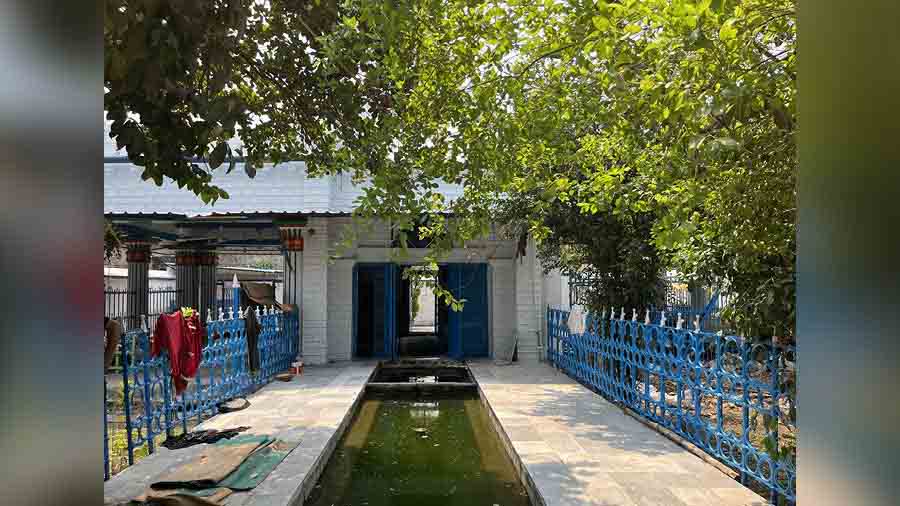
The charming wuzu pond at Shahi Masjid, overhung with greenery
Bichali Ghat where the nawab landed, and tales of a tiger that swam across
Leaving behind the calmness of the mosque, we headed towards Bichali ghat, where Wajid Ali Shah first set foot on these shores. Bichali means hay (or bhoosa in Hindi), and this ghat is a centre for loading bamboo used throughout Bengal for construction and scaffolding.
The scene here was chaotic; with swerving cycle rickshaws, big thelas loaded with bamboo, steamers disgorging a constant stream of passengers. On the opposite shore of the bloated Hooghly, we could see the luxuriant greenery of the Botanical Gardens and further upstream, the Vidyasagar Setu bridge and the tall buildings of Kolkata.
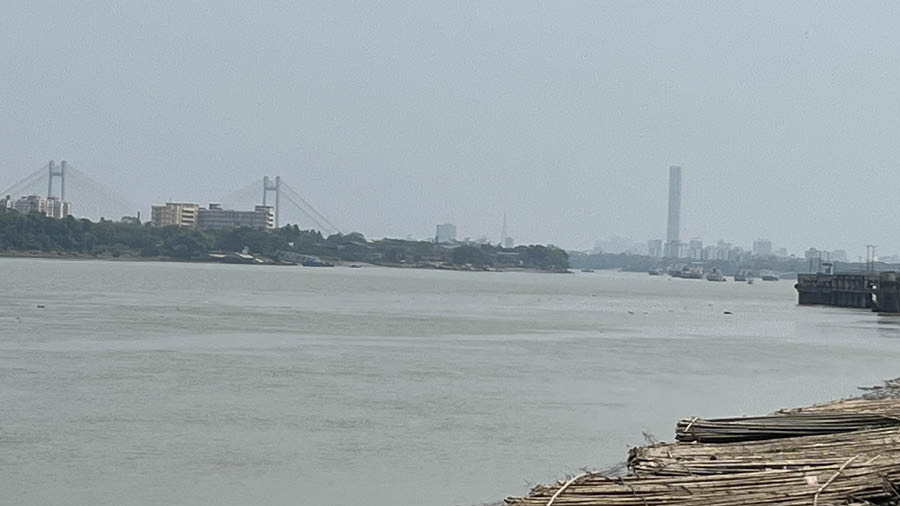
Kolkata upstream – the Vidyasgar Setu and a cluster of high-rises with the towering 42 skyscraper, as seen from Bichali Ghat today
Here, Sohail told me about the Nawab’s exotic animals. Wajid Ali’s interest in animals was extraordinary. According to the book by Rosie Llwellyn-Jones, his collection included tigers, leopards, spotted deer, all sorts of birds – partridges, ostriches, turkeys, herons, cranes – monkeys from far flung places, a pool filled with fish, even a pair of giraffes, and amazingly, an artificial hill with thousands of snakes.* He had over 800 attendants to look after the animals.
One cold January morning, a tiger from his menagerie escaped and swam across the Hooghly. Startled attendants spotted it on the opposite shore, in the thick morning fog, among the trees of the Botanical Gardens. Before an alarm could be raised, the tiger mauled and injured a German botanist researcher, Adolf Biermann. The tiger was shot dead, but the British had had enough. They prevailed upon the Nawab to house his animals in a zoo instead, and this was the beginning of the Alipore Zoological Gardens (today’s Alipore Zoo).
The Shahi Imambara, burial place of the last Nawab of Awadh
We entered the Shahi Imambara, completed in 1864, the biggest such structure built by Wajid Ali Shah in Metiabruz. On either side of its arched entrance was engraved a fish, the state insignia of Awadh symbolizing freedom from restraint and the life-giving properties of water.
We took off our shoes and climbed the short flight of stairs, entering its cool marble interior. On one side, behind an iron grill, was the gold-colored tomb of Wajid Ali Shah.

The final resting place of Wajid Ali Shah
Besides the last Nawab of Awadh, other family members too are buried here. There were plaques on the wall tracing the family tree, and wall hangings with different newspaper articles that reflected the torturous infighting of the Awadh royal lineage.
When Wajid Ali Shah left Lucknow for Kolkata in 1856, he left behind his queen Hazrat Mahal and his young son Birjis Qudr. The feisty Hazrat Mahal went on to live an extraordinary life, valiantly fighting the British during the Revolt of 1857, determined to keep her independence and the rights of her son. She was defeated and fled to Nepal where she was given asylum by the Nepalese king. Hazrat Mahal eventually died in Kathmandu and is buried there, while her son Birjis Qudr returned to India in 1887, only to be allegedly poisoned to death by jealous relatives.
Last stop, the most beautiful of all
Sharing a boundary wall with the Shahi Imambara is the beautiful Umdah Imambara, our last stop.
Umdah means excellent in Urdu, and the name does this place justice. It was built by one of the Nawab’s mutah wives, which is a now-frowned-upon custom where a “temporary” marriage is arranged for a specific period, often with a payment consideration. The Nawab had several mutah wives, a convenient way to side-step a full nikah marriage, which came with its own obligations.
This building is known for its unique inlay work on the walls, with stunningly intricate floral patterns made of painted glass and stuck on plaster of Paris, creating dazzling wall designs.
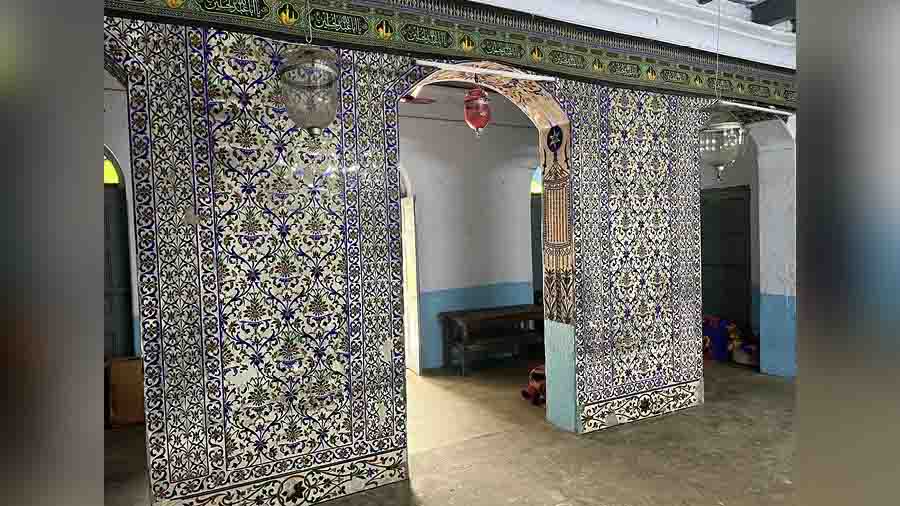
The brilliant floral walls of Umdah Imambara
Whew, Metiabruz!
What a discovery-filled few hours this locality provides. With an immersion in to something much more than mere monument-sighting. This was contextual history, the first-hand viewing of a cross-fertilisation of cultures. And a deeper understanding of the layered history of Kolkata, which has made this city the wonderful melting pot it is today.
How to get there:
- To get to Metiabruz, drive past the Kidderpore docks and the big ITC factory, over railway tracks and walled compounds filled with shipping containers. You will see the clock tower on your left.
- Start your walk from the Garden Reach clock tower, from where all the attractions are within walking distance.
Information:
- It's best to do this walk in the morning, between 9am and noon.
- Visiting the main attractions should take 2 to 3 hours
- The imambaras are generally open and one is free to visit for as long as one wants
- Free entry
- No toilet facilities
- No wheelchair access
- Parking is available opposite the clock tower.
* “Lucknow: The last phase of an Oriental Culture”, chapter1, pg 126, pg3, 127,74, 72-73
Adil Ahmad is a Kolkata-born discoverer deeply curious about the city’s heritage and history. He can be reached at hello@indiaheritage.in
